Borane–Trimethylamine Complex: A Versatile Reagent in Organic Synthesis
Abstract
:1. Introduction
2. Reductive Transformations with Carbon–Oxygen Double Bond
2.1. Reduction of Ketones
2.2. Reductive Bromation of Aromatic Carbonyl Compounds
2.3. Reduction of Carboxylic Acids
2.4. Reductive Methylation with CO2
3. Carbon–Nitrogen Double Bond Reduction
3.1. Reduction of Hydrazones and Azines
3.2. Reduction of Oximes
3.3. Transfer Hydrogenation of Aromatic N-Heterocycles
3.4. Selective N-Monomethylation of Primary Anilines
4. Reduction of Nitrobenzenes to Anilines
5. Reductive Deprotection of N-Tritylamines
6. Photocatalytic Difluoromethylation of Unactivated Alkenes
7. Reductive Cleavage of Acetals
8. Conclusions
Funding
Data Availability Statement
Conflicts of Interest
References
- Lane, C.F. The borane.amine complexes. Aldrichimica Acta 1973, 6, 51–58. [Google Scholar]
- Hutchins, R.O.; Learn, K.; Nazer, B.; Pytlewski, D.; Pelter, A. Amine boranes as selective reducing and hydroborating agents. A review. Org. Prep. Proced. Int. 1984, 16, 335–372. [Google Scholar] [CrossRef]
- Carboni, B.; Monnier, B. Recent developments in the chemistry of amine- and phosphine-boranes. Tetrahedron 1999, 55, 1197–1248. [Google Scholar] [CrossRef]
- Matos, K.; Pichlmair, S.; Burkhardt, E.R. Boron reagents for reductive amination. Chim. Oggi 2007, 25, 17–20. [Google Scholar]
- Matos, K.; Burkhardt, E.R. Direct reductive amination with amine boranes. In Pharmaceutical Process Chemistry, 1st ed.; Shioiri, T., Izawa, K., Konoike, T., Eds.; Wiley: New York, NY, USA, 2010; pp. 127–143. [Google Scholar] [CrossRef]
- Sumerin, V.; Chernichenko, K.; Schulz, F.; Lesleka, M.; Rieger, B.; Repo, T. Amine-borane mediated metal-free hydrogen activation and catalytic hydrogenation. In Frustrated Lewis Pairs I; Erker, G., Douglas, W.S., Eds.; Topics in Current Chemistry; Springer: Berlin/Heidelberg, Germany, 2012; Volume 332, pp. 111–155. [Google Scholar] [CrossRef]
- Lau, S.; Gasperini, D.; Webster, R.L. Amine–boranes as transfer hydrogenation and hydrogenation reagents: A mechanistic perspective». Angew. Chem. Int. Ed. 2021, 60, 14272–14294. [Google Scholar] [CrossRef]
- Faverio, C.; Boselli, M.F.; Medici, F.; Benaglia, M. Ammonia borane as a reducing agent in organic synthesis. Bioinorg. Chem. Appl. 2020, 18, 7789–7813. [Google Scholar] [CrossRef]
- Karthikeyan, S.; Sedlak, R.; Hobza, P. On the nature of stabilization in weak, medium, and strong charge-transfer complexes: CCSD(T)/CBS and SAPT calculations. J. Phys. Chem. A 2011, 115, 9422–9428. [Google Scholar] [CrossRef]
- Lo, R.; Manna, D.; Lamanec, M.; Dračínský, M.; Bouř, P.; Wu, T.; Bastien, G.; Kaleta, J.; Miriyala, M.V.; VŠpirko, V.; et al. The stability of covalent dative bond significantly increases with increasing solvent polarity. Nat. Commun. 2022, 13, 2107. [Google Scholar] [CrossRef]
- Funke, M.-A.; Mayr, H. Kinetics and mechanism of the reactions of amine boranes with carbenium ions. Chem. Eur. J. 1997, 3, 1214–1222. [Google Scholar] [CrossRef]
- Gohzu, S.; Tada, M. Regioselective reduction of polyketones on silica gel surface with borane–trimethylamine complex. Chem. Lett. 1986, 15, 61–64. [Google Scholar] [CrossRef]
- Sarko, C.R.; Guch, I.C.; DiMare, M. Chelation-controlled protocol for the diastereoselective reduction of ketones. J. Org. Chem. 1994, 59, 705–706. [Google Scholar] [CrossRef]
- Zhang, Y.; Ye, Q.; Ponomareva, L.V.; Cao, Y.; Liu, Y.; Cui, Z.; Van Lanen, S.G.; Voss, S.R.; She, Q.-B.; Thorson, J.S. Total synthesis of griseusins and elucidation of the griseusin mechanism of action. Chem. Sci. 2019, 10, 7641–7648. [Google Scholar] [CrossRef]
- Le Corre, M.; Gheerbrant, E.; Le Deit, H. Trimethylamine–borane bromide as alternative reagent for reductive bromation of aromatic carbonyl compounds. J. Chem. Soc. Chem. Commun. 1989, 5, 313–314. [Google Scholar] [CrossRef]
- Malmquist, J.; Ström, P. Multiple labeling of a potent CX3CR1 antagonist for the treatment of multiple sclerosis. J. Label. Compd. Radiopharm. 2012, 55, 387–392. [Google Scholar] [CrossRef]
- Stengel, I.; Götz, G.; Weil, M.; Bäuerle, P. A dinuclear (Bpy)Pt II -decorated crownophane. Eur. J. Org. Chem. 2015, 18, 3887–3893. [Google Scholar] [CrossRef]
- Trapani, G.; Reho, A.; Latrofa, A.; Liso, G. Trimethylamine-borane a useful reagent in the one-pot preparation of carboxylic esters from carboxylic acids. Synthesis 1990, 9, 853–854. [Google Scholar] [CrossRef]
- Trapani, G.; Reho, A.; Latrofa, A. Trimethylamine-borane as useful reagent in the N-acylation or N-alkylation of amines by carboxylic acids. Synthesis 1983, 12, 1013–1014. [Google Scholar] [CrossRef]
- Ménard, G.; Stephan, D.W. CO2 reduction via aluminum complexes of ammonia boranes. Dalton Trans. 2013, 42, 5447–5453. [Google Scholar] [CrossRef]
- Roy, L.; Ghosh, B.; Paul, A. Lewis acid promoted hydrogenation of CO2 and HCOO—By amine boranes: Mechanistic insight from a computational approach. J. Phys. Chem. A 2017, 121, 5204–5216. [Google Scholar] [CrossRef]
- Zhang, X.; Wang, S.; Xi, C. α-Methylation of 2-arylacetonitrile by a trimethylamine-borane-CO2 system. J. Org. Chem. 2019, 84, 9744–9749. [Google Scholar] [CrossRef]
- Zhang, Y.; Zhang, H.; Gao, K. Borane–trimethylamine complex as a reducing agent for selective methylation and formylation of amines with CO2. Org. Lett. 2021, 23, 8282–8286. [Google Scholar] [CrossRef]
- Xiong, F.; Cheng, Q.; Dang, Y.; Gao, K. A tandem reduction of primary amines, carbonyl compounds, CO2, and boranes catalyzed by in situ formed frustrated lewis pairs. Org. Chem. Front. 2022, 9, 4882–4889. [Google Scholar] [CrossRef]
- Perdicchia, D.; Licandro, E.; Maiorana, S.; Baldoli, C.; Giannini, C. A new ‘one-pot’ synthesis of hydrazides by reduction of hydrazones. Tetrahedron 2003, 59, 7733–7742. [Google Scholar] [CrossRef]
- Perdicchia, D. Ionic hydrogenation of azines: An efficient synthesis of 1,2-dialkylhydrazines. Tetrahedron 2023, 139, 133432. [Google Scholar] [CrossRef]
- Plate, R.; Hermkens, P.H.H.; Smits, J.M.M.; Ottenheijm, H.C.G. Nitrone cycloaddition in the stereoselective synthesis of β-carbolines from N-hydroxytryptophan. J. Org. Chem. 1986, 51, 309–314. [Google Scholar] [CrossRef]
- Plate, R.; Hermkens, P.H.H.; Smits, J.M.M.; Nivard, R.J.F.; Ottenheijm, H.C.G. Employment of nitriles in the stereoselective cycloaddition to nitrones. J. Org. Chem. 1987, 52, 1047–1051. [Google Scholar] [CrossRef]
- Hermkens, P.H.H.; Van Maarseveen, J.H.; Berens, H.W.; Smits, J.M.M.; Kruse, C.G.; Scheeren, H.W. Intramolecular Pictet-Spengler reaction of N-alkoxytryptophans and tryptamines. 2. Synthesis of corynanthe alkaloid derivatives containing a tetrahydro-1,2-oxazine as the D ring. J. Org. Chem. 1990, 55, 2200–2206. [Google Scholar] [CrossRef]
- Hermkens, P.H.H.; Van Maarseveen, J.H.; Cobben, P.L.H.M.; Ottenheijm, H.C.G.; Kruse, C.G.; Scheeren, H.W. Syntheses of 1,3-disubstituted N-oxy-β-carbolines by the Pictet-Spengler reactions of N-oxy-tryptophan and -tryptamine derivatives. Tetrahedron 1990, 46, 833–846. [Google Scholar] [CrossRef]
- Plate, R.; Ottenheijm, H.C.G. Synthesis of 2-(dimethylallyl)-N-hydroxytryptophans from indole. Tetrahedron Lett. 1986, 27, 3755–3758. [Google Scholar] [CrossRef]
- Plate, R.; Nivard, R.J.F.; Ottenheijm, H.C.G. Conversion of N-hydroxytryptophans into α,β-dehydrotryptophan. An approach to the neoechinulin series. J. Chem. Soc. Perkin Trans. 1 1987, 2473–2480. [Google Scholar] [CrossRef]
- Pham, T.L.; Sae-Lao, P.; Toh, H.H.M.; Csókás, D.; Bates, R.W. The total synthesis of Raistrickindole A. J. Org. Chem. 2022, 87, 16111–16114. [Google Scholar] [CrossRef]
- Lawrence, J.; Cointeaux, L.; Maire, P.; Vallée, Y.; Blandin, V. N-Hydroxy and N-acyloxy peptides: Synthesis and chemical modifications. Org. Biomol. Chem. 2006, 4, 3125–3141. [Google Scholar] [CrossRef]
- Langenhan, J.M.; Endo, M.M.; Engle, J.M.; Fukumoto, L.L.; Rogalsky, D.R.; Slevin, L.K.; Fay, L.R.; Lucker, R.W.; Rohlfing, J.R.; Smith, K.R.; et al. Synthesis and biological evaluation of RON-neoglycosides as tumor cytotoxins. Carbohydr. Res. 2011, 346, 2663–2676. [Google Scholar] [CrossRef]
- Goff, R.D.; Thorson, J.S. Enhancing the divergent activities of betulinic acid via neoglycosylation. Org. Lett. 2009, 11, 461–464. [Google Scholar] [CrossRef]
- Zhang, J.; Ponomareva, L.V.; Marchillo, K.; Zhou, M.; Andes, D.R.; Thorson, J.S. The synthesis and antibacterial activity of doxycycline neoglycosides. J. Nat. Prod. 2013, 76, 1627–1636. [Google Scholar] [CrossRef]
- Nielsen, S.D.; Smith, G.; Begtrup, M.; Kristensen, J.L. Synthesis and application of a new fluorous-tagged ammonia equivalent. Chem. Eur. J. 2010, 16, 4557–4566. [Google Scholar] [CrossRef]
- Heusler, A.; Fliege, J.; Wagener, T.; Glorius, F. Substituted dihydropyridine synthesis by dearomatization of pyridines. Angew. Chem. Int. Ed. 2021, 60, 13793–13797. [Google Scholar] [CrossRef]
- Zeng, Y.-F.; Li, Y.-N.; Zhou, M.-X.; Han, S.; Guo, Y.; Wang, Z. Metal-free hydrogenation of N-heterocycles with trimethylamine borane and TFA in aqueous solution. Adv. Synth. Catal. 2022, 364, 3664–3669. [Google Scholar] [CrossRef]
- Zeng, Y.-F.; Zhou, M.-X.; Li, Y.-N.; Wu, X.; Guo, Y.; Wang, Z. Switchable reductive N-trifluoroethylation and N-trifluoroacetylation of indoles with trifluoroacetic acid and trimethylamine borane. Org. Lett. 2022, 24, 7440–7445. [Google Scholar] [CrossRef]
- Li, Y.-N.; Zhou, M.-X.; Wu, J.-B.; Wang, Z.; Zeng, Y.-F. Tandem reduction and trifluoroethylation of quinolines and quinoxalines with trifluoroacetic acid and trimethylamine borane. Org. Biomol. Chem. 2022, 20, 9613–9617. [Google Scholar] [CrossRef]
- Meng, J.; Xia, H.M.; Xu, A.-Q.; Wang, Y.-F.; Wang, Z.; Zhang, F.-L. Selective N-monomethylation of primary anilines with the controllable installation of N-CH2D, N-CHD2, and N-CD3 units. Org. Biomol. Chem. 2020, 18, 4922–4926. [Google Scholar] [CrossRef]
- Couturier, M.; Tucker, J.L.; Andresen, B.M.; Dubé, P.; Brenek, S.J.; Negri, J.T. Palladium catalyzed activation of borane–amine adducts: Rate enhancement of amine–borane methanolysis in the reduction of nitrobenzenes to anilines. Tetrahedron Lett. 2001, 42, 2285–2288. [Google Scholar] [CrossRef]
- Beaudin, J.; Bourassa, D.E.; Bowles, P.; Castaldi, M.J.; Clay, R.; Couturier, M.A.; Karrick, G.; Makowski, T.W.; McDermott, R.E.; Meltz, C.N.; et al. Synthesis and purification of 6-ethoxy-4-oxo-1,4-dihydro-[1,5]naphthyridine-3-carboxylic acid benzylamide. Org Process Res Dev 2003, 7, 873–878. [Google Scholar] [CrossRef]
- Klapars, E.A.V.; Naidu, B.N.; Piotrowski, D.W.; Tucci, F.C. Enantiocontrolled synthesis of (1S,2S)-6-desmethyl-(methylaziridino)mitosene. J. Am. Chem. Soc. 2000, 122, 5401–5402. [Google Scholar] [CrossRef]
- Vedejs, E.; Naidu, B.N.; Klapars, A.; Warner, D.L.; Li, V.-S.; Na, Y.; Kohn, H. Synthetic enantiopure aziridinomitosenes: Preparation, reactivity, and DNA alkylation studies. J. Am. Chem. Soc. 2003, 125, 15796–157806. [Google Scholar] [CrossRef]
- Vedejs, E.; Klapars, A.; Warner, D.L.; Weiss, A.H. Reductive deprotection of N-tritylaziridines. J. Org. Chem. 2001, 66, 7542–7546. [Google Scholar] [CrossRef]
- Park, J.-J.; Lee, J.H.; Li, Q.; Diaz, K.; Chang, Y.-T.; Chung, S.-K. Divergent syntheses of all stereoisomers of phytosphingosine and their use in the construction of a ceramide library. Bioorg. Chem. 2008, 36, 220–228. [Google Scholar] [CrossRef]
- Zhang, Z.-Q.; Sang, Y.-Q.; Wang, C.-Q.; Dai, P.; Xue, X.-S.; Piper, J.L.; Peng, Z.-H.; Ma, J.-A.; Zhang, F.-G.; Wu, J. Difluoromethylation of unactivated alkenes using freon-22 through tertiary amine-borane-triggered halogen atom transfer. J. Am. Chem. Soc. 2022, 144, 14288–14296. [Google Scholar] [CrossRef]
- Ek, M.; Garegg, P.J.; Hultberg, H.; Oscarson, S. Reductive ring openings of carbohydrate benzylidene acetals using borane-trimethylamine and aluminium chloride. Regioselectivity and solvent dependance. J. Carbohydr. Chem. 1983, 2, 305–311. [Google Scholar] [CrossRef]
- Fügedi, P.; Birberg, W.; Garegg, P.J.; Pilotti, A. Syntheses of a branched heptasaccharide having phytoalexin-elicitor activity. Carbohydr. Res. 1987, 164, 297–312. [Google Scholar] [CrossRef]
- Sato, S.; Nunomura, S.; Nakano, T.; Ito, Y.; Ogawa, T. An efficient approach to stereoselective glycosylation of ceramide derivatives: Use of pivaloyl group as a stereocontrolling auxiliary. Tetrahedron Lett. 1988, 29, 4097–4100. [Google Scholar] [CrossRef]
- Garegg, P.J. Saccharides of biological importance: Challenges and opportunities for organic synthesis. Acc. Chem. Res. 1992, 25, 575–580. [Google Scholar] [CrossRef]
- Garegg, P.J.; Olsson, L.; Oscarson, S. Synthesis of methyl (ethyl 2-O-acyl-3,4-di-O-benzyl-1-thio-β-D-glucopyranosid)uronates and evaluation of their use as reactive β-selective glucuronic acid donors. J. Org. Chem. 1995, 60, 2200–2204. [Google Scholar] [CrossRef]
- Karst, N.; Jacquinet, J.-C. Chemical synthesis of β-D-GlcpA(2SO4)-(1→3)-D-GalpNAc(6SO4), the disaccharide repeating unit of shark cartilage chondroitin sulfate D, and of its methyl β-D-glycoside derivative. J. Chem. Soc. Perkin Trans. 1 2000, 16, 2709–2717. [Google Scholar] [CrossRef]
- Svansson, L.; Johnston, B.D.; Gu, J.-H.; Patrick, B.; Pinto, B.M. Synthesis and conformational analysis of a sulfonium-ion analogue of the glycosidase inhibitor castanospermine. J. Am. Chem. Soc. 2000, 122, 10769–10775. [Google Scholar] [CrossRef]
- Li, X.; Ohtake, H.; Takahashi, H.; Ikegami, S. Direct methylenation of partially benzyl-protected sugar lactones by dimethyltitanocene. Synlett 2001, 12, 1885–1888. [Google Scholar] [CrossRef]
- Hoffmann, B.; Zanini, D.; Ripoche, I.; Bürli, R.; Vasella, A. Oligosaccharide analogues of polysaccharides, part 22, synthesis of cyclodextrin analogues containing a buta-1,3-diyne-1,4-diyl or a butane-1,4-diyl unit. Helv. Chim. Acta 2001, 84, 1862–1888. [Google Scholar] [CrossRef]
- Sherman, A.A.; Yudina, O.N.; Mironov, Y.V.; Sukhova, E.V.; Shashkov, A.S.; Menshov, V.M.; Nifantiev, N.E. Study of glycosylation with N-trichloroacetyl-D-glucosamine derivatives in the syntheses of the spacer-armed pentasaccharides sialyl lacto-N-neotetraose and sialyl lacto-N-tetraose, their fragments, and analogues. Carbohydr. Res. 2001, 336, 13–46. [Google Scholar] [CrossRef]
- Kitov, P.I.; Bundle, D.R. Synthesis and structure–activity relationships of di- and trisaccharide inhibitors for Shiga-like toxin type 1. J. Chem. Soc. Perkin Trans. 1 2001, 8, 838–853. [Google Scholar] [CrossRef]
- Sherman, A.A.; Yudina, O.N.; Shashkov, A.S.; Menshov, V.M.; Nifant’ev, N.E. Synthesis of Neu5Ac- and Neu5Gc-α-(2→6′)-lactosamine 3-aminopropyl glycosides. Carbohydr. Res. 2001, 330, 445–458. [Google Scholar] [CrossRef] [PubMed]
- Amaya, T.; Tanaka, H.; Yamaguchi, T.; Naoto Shibuya, N.; Takahashi, T. The first synthesis of tetraglucosyl glucitol having phytoalexin-elicitor activity in rice cells based on a sequential glycosylation strategy. Tetrahedron Lett. 2001, 42, 9191–9194. [Google Scholar] [CrossRef]
- Chowdhury, A.R.; Siriwardena, A.; Boons, G.-J. A highly convergent approach for the synthesis of disaccharide repeating units of peptidoglycan. Tetrahedron Lett. 2002, 43, 7805–7807. [Google Scholar] [CrossRef]
- Elsayed, G.A.; Zhu, T.; Boons, G.-J. Demixing libraries of saccharides using a multi-linker approach in combination with a soluble polymeric support. Tetrahedron Lett. 2002, 43, 4691–4694. [Google Scholar] [CrossRef]
- Dohi, H.; Nishida, Y.; Furuta, Y.; Uzawa, H.; Yokoyama, S.-I.; Ito, S.; Mori, H.; Kobayashi, K. Molecular design and biological potential of galacto-type trehalose as a nonnatural ligand of Shiga toxins. Org. Lett. 2002, 4, 355–357. [Google Scholar] [CrossRef]
- Manabe, S.; Ito, Y. On-resin real-time reaction monitoring of solid-phase oligosaccharide synthesis. J. Am. Chem. Soc. 2002, 124, 12638–12639. [Google Scholar] [CrossRef]
- Takahashi, T.; Okano, A.; Amaya, T.; Tanaka, H.; Doi, T. Solid-Phase Synthesis of a phytoalexin elicitor-active tetraglucosyl glucitol. Synlett 2002, 6, 911–914. [Google Scholar] [CrossRef]
- Kanemitsu, T.; Wong, C.-H.; Kanie, O. Solid-phase synthesis of oligosaccharides and on-resin quantitative monitoring using gated decoupling 13C NMR. J. Am. Chem. Soc. 2002, 124, 3591–3599. [Google Scholar] [CrossRef]
- Ágoston, K.; Kerékgyártó, J.; Hajkó, J.; Batta, G.; Lefeber, D.J.; Kamerling, J.P.; Vliegenthart, J.F.G. Synthesis of fragments of the glycocalyx glycan of the Parasiteschistosoma mansoni. Chem. Eur. J. 2002, 8, 151–161. [Google Scholar] [CrossRef]
- Tanaka, H.; Amaya, T.; Takahashi, T. Parallel synthesis of multi-branched oligosaccharides related to elicitor active pentasaccharide in rice cell based on orthogonal deprotection and glycosylation strategy. Tetrahedron Lett. 2003, 44, 3053–3057. [Google Scholar] [CrossRef]
- Alpe, M.; Oscarson, S.; Svahnberg, P. Synthesis of Cryptococcus neoformans capsular polysaccharide structures. IV. Construction of thioglycoside donor blocks and their subsequent assembly. J. Carbohydr. Chem. 2003, 22, 565–577. [Google Scholar] [CrossRef]
- Tarling, C.A.; Withers, S.G. The synthesis of a series of modified mannotrisaccharides as probes of the enzymes involved in the early stages of mammalian complex N-glycan formation. Carbohydr. Res. 2004, 339, 2487–2497. [Google Scholar] [CrossRef]
- Tsvetkov, Y.E.; Nifantiev, N.E. Enhanced sialylating activity of O-chloroacetylated 2-thioethyl sialosides. Synlett 2005, 9, 1375–1380. [Google Scholar] [CrossRef]
- Wang, J.; Li, J.; Chen, H.-N.; Chang, H.; Tanifum, C.T.; Liu, H.-H.; Czyryca, P.G.; Chang, C.-W.T. Glycodiversification for the optimization of the Kanamycin class aminoglycosides. J. Med. Chem. 2005, 48, 6271–6285. [Google Scholar] [CrossRef]
- Veselý, J.; Rohlenová, A.; Džoganová, M.; Trnka, T.; Tišlerová, I.; Šaman, D.; Ledvina, M. Preparation of ethyl 2-azido-2-deoxy-1-thio-β-D-mannopyranosides, and their rearrangement to 2-S-ethyl-2-thio-β-D-mannopyranosylamines. Synthesis 2006, 4, 699–705. [Google Scholar] [CrossRef]
- Khatuntseva, E.A.; Tsvetkov, Y.E.; Grachev, A.A.; Nifant’ev, N.E. Synthesis of aminoethyl glycosides of type 2 chain A tetrasaccharide and related trisaccharides. Russ. J. Org. Chem. 2005, 41, 1814–1823. [Google Scholar] [CrossRef]
- Matsuoka, K.; Goshu, Y.; Takezawa, Y.; Mori, T.; Sakamoto, J.-I.; Yamada, A.; Onaga, T.; Koyama, T.; Hatano, K.; Snyder, P.W.; et al. Practical synthesis of fully protected globotriaose and its glycopolymers. Carbohydr. Polym. 2007, 69, 326–335. [Google Scholar] [CrossRef]
- Yamada, A.; Hatano, K.; Matsuoka, K.; Koyama, T.; Esumi, Y.; Koshino, H.; Hino, K.; Nishikawa, K.; Natori, Y.; Terunuma, D. Syntheses and Vero toxin-binding activities of carbosilane dendrimers periphery-functionalized with galabiose. Tetrahedron 2006, 62, 5074–5083. [Google Scholar] [CrossRef]
- Komarova, B.S.; Tsvetkov, Y.E.; Knirel, Y.A.; Zähringer, U.; Pier, G.B.; Nifantiev, N.E. Synthesis of a common trisaccharide fragment of glycoforms of the outer core region of the Pseudomonas aeruginosa lipopolysaccharide. Tetrahedron Lett. 2006, 47, 3583–3587. [Google Scholar] [CrossRef]
- Nakano, J.; Akihiro Ishiwata, A.; Ohta, H.; Ito, Y. Synthesis of complex-type glycans derived from parasitic helminths. Carbohydr. Res. 2007, 342, 675–695. [Google Scholar] [CrossRef]
- Sukhova, E.V.; Dubrovskii, A.V.; Tsvetkov, Y.E.; Nifantiev, N.E. Synthesis of oligosaccharides related to the HNK-1 antigen. 5. Synthesis of a sulfo-mimetic of the HNK-1 antigenic trisaccharide. Russ. Chem. Bull. 2007, 56, 1655–1670. [Google Scholar] [CrossRef]
- Tatai, J.; Osztrovszky, G.; Kajtár-Peredy, M.; Fügedi, P. An efficient synthesis of L-idose and L-iduronic acid thioglycosides and their use for the synthesis of heparin oligosaccharides. Carbohydr. Res. 2008, 343, 596–606. [Google Scholar] [CrossRef]
- Komarova, B.S.; Tsvetkov, Y.E.; Pier, G.B.; Nifantiev, N.E. First Synthesis of pentasaccharide glycoform I of the outer core region of the Pseudomonas aeruginosa lipopolysaccharide. J. Org. Chem. 2008, 73, 8411–8421. [Google Scholar] [CrossRef]
- Lin, Y.-S.; Tungpradit, R.; Sinchaikul, S.; An, F.-M.; Liu, D.-Z.; Phutrakul, S.; Chen, S.-T. Targeting the delivery of glycan-based paclitaxel prodrugs to cancer cells via glucose transporters. J. Med. Chem. 2008, 51, 7428–7441. [Google Scholar] [CrossRef]
- Schwardt, O.; Gäthje, H.; Vedani, A.; Mesch, S.; Gao, G.-P.; Spreafico, M.; von Orelli, J.; Kelm, S.; Ernst, B.J. Examination of the Biological Role of the α (2→ 6)-Linked Sialic Acid in Gangliosides Binding to the Myelin-Associated Glycoprotein (MAG). Med. Chem. 2009, 52, 989–1004. [Google Scholar] [CrossRef]
- Rasmussen, T.S.; Jensen, H.H. Chiral pool synthesis of calystegine A3 from 2-deoxyglucose via a Brown allylation. Carbohydr. Res. 2011, 346, 2855–2861. [Google Scholar] [CrossRef]
- Titz, A.; Marra, A.; Cutting, B.; Smieško, M.; Papandreou, G.; Dondoni, A.; Ernst, B. Conformational constraints: Nature does it best with sialyl Lewisx. Eur. J. Org. Chem. 2012, 28, 5534–5539. [Google Scholar] [CrossRef]
- Xia, L.; Zheng, R.B.; Lowary, T.L. Revisiting the specificity of an α-(1→4)-mannosyltransferase involved in mycobacterial methylmannose polysaccharide biosynthesis. ChemBioChem 2012, 13, 1139–1151. [Google Scholar] [CrossRef]
- Tamura, J.-I.; Tsutsumishita-Nakai, N.; Nakao, Y.; Kawano, M.; Kato, S.; Takeda, N.; Nadanaka, S.; Kitagawa, H. Synthesis and interaction with Midkine of biotinylated chondroitin sulfate tetrasaccharides. Bioorg. Med. Chem. Lett. 2012, 22, 1371–1374. [Google Scholar] [CrossRef]
- Takeda, N.; Ikeda-Matsumi, R.; Ebara-Nagahara, K.; Otaki-Nanjo, M.; Taniguchi-Morita, K.; Nanjo, M.; Tamura, J.-I. Synthesis of heparan sulfate tetrasaccharide as a substrate for human heparanase. Carbohydr. Res. 2012, 353, 13–21. [Google Scholar] [CrossRef] [PubMed]
- Komarova, B.S.; Tsvetkov, Y.E.; Pier, G.P.; Nifantiev, N.E. Synthesis of pentasaccharides corresponding to the glycoform II of the outer core region of the Pseudomonas aeruginosa lipopolysaccharide. Carbohydr. Res. 2012, 360, 56–68. [Google Scholar] [CrossRef]
- Zhang, J.; Zou, L.; Lowary, T.L. Synthesis of the tolerance-inducing oligosaccharide lacto-N-fucopentaose III bearing an activated linker. ChemistryOpen 2013, 2, 156–163. [Google Scholar] [CrossRef] [PubMed]
- Kitamura, Y.; Koshino, H.; Nakamura, T.; Tsuchida, A.; Nitoda, T.; Kanzaki, H.; Matsuoka, K.; Takahashi, S. Total synthesis of the proposed structure for pochonicine and determination of its absolute configuration. Tetrahedron Lett. 2013, 54, 1456–1459. [Google Scholar] [CrossRef]
- Yudina, O.N.; Tsvetkov, Y.E.; Nifantiev, N.E. Synthesis of 2-aminoethyl glycosides of chitooligosaccharides. Russ. Chem. Bull. 2015, 64, 2932–2941. [Google Scholar] [CrossRef]
- Fan, Q.-H.; Pickens, J.B.; Striegler, S.; Gervaise, C.D. Illuminating the binding interactions of galactonoamidines during the inhibition of β-galactosidase (E. coli). Bioorg. Med. Chem. 2016, 24, 661–671. [Google Scholar] [CrossRef] [PubMed]
- d’Ortoli, T.A.; Widmalm, G. Synthesis of the tetrasaccharide glycoside moiety of Solaradixine and rapid NMR-based structure verification using the program CASPER. Tetrahedron 2016, 72, 912–927. [Google Scholar] [CrossRef]
- Vinnitskiy, D.Z.; Ustyuzhanina, N.E.; Andrey, S.D.; Shashkov, A.S.; Nifantiev, N.E. Synthesis and NMR analysis of model compounds related to fucosylated chondroitin sulfates: GalNAc and Fuc(1 → 6)GalNAc derivatives. Carbohydr. Res. 2017, 438, 9–17. [Google Scholar] [CrossRef]
- Tsvetkov, Y.E.; Yashunsky, D.V.; Sukhova, E.V.; Kurbatova, E.A.; Nifantiev, N.E. Synthesis of oligosaccharides structurally related to fragments of Streptococcus pneumoniae type 3 capsular polysaccharide. Russ. Chem. Bull. 2017, 66, 111–122. [Google Scholar] [CrossRef]
- Demeter, F.; Veres, F.; Herczeg, M.; Borbás, A. Short synthesis of Idraparinux by applying a 2-O-Methyl-4,6-O-arylmethylene thioidoside as a 1,2-trans-α-selective glycosyl donor. Eur. J. Org. Chem. 2018, 48, 6901–6912. [Google Scholar] [CrossRef]
- Tateda, N.; Ajisaka, K.; Ishiguro, M.; Miyazaki, T. Synthesis of 5a,5a′-dicarba-D-glucobioses from conformationally restricted carbaglucosyl triflates using SN2-type inversion with carbaglucosyl nucleophiles. Bioorg. Med. Chem. 2019, 27, 2345–2367. [Google Scholar] [CrossRef]
- Dhaene, S.; Van Der Eycken, J.; Beerens, K.; Franceus, J.; Desmet, T.; Caroen, J. Synthesis, trehalase hydrolytic resistance and inhibition properties of 4- and 6-substituted trehalose derivatives. J. Enzyme Inhib. Med. Chem. 2020, 35, 1964–1989. [Google Scholar] [CrossRef]
- Inamura, S.; Fukase, K.; Kusumoto, S. Synthetic study of peptidoglycan partial structures. synthesis of tetrasaccharide and octasaccharide fragments. Tetrahedron Lett. 2001, 42, 7613–7616. [Google Scholar] [CrossRef]
- Hesek, D.; Lee, M.; Morio, K.-I.; Mobashery, S. Synthesis of a fragment of bacterial cell wall. J. Org. Chem. 2004, 69, 2137–2146. [Google Scholar] [CrossRef]
- Inamura, S.; Fujimoto, Y.; Kawasaki, A.; Shiokawa, Z.; Woelk, E.; Heine, H.; Lindner, B.; Inohara, N.; Kusumoto, S.; Fukase, K. Synthesis of peptidoglycan fragments and evaluation of their biological activity. Org. Biomol. Chem. 2006, 4, 232–242. [Google Scholar] [CrossRef] [PubMed]
- Bohn, M.L.; Colombo, M.I.; Stortz, C.A.; Rúveda, E.A. A comparative study of the influence of some protecting groups on the reactivity of D-glucosamine acceptors with a galactofuranosyl donor. Carbohydr. Res. 2006, 341, 1096–1104. [Google Scholar] [CrossRef]
- Bohn, M.L.; Colombo, M.I.; Pisano, P.L.; Stortz, C.A.; Rúveda, E.A. Differential O-3/O-4 regioselectivity in the glycosylation of α and β anomers of 6-O-substituted N-dimethylmaleoyl-protected D-glucosamine acceptors. Carbohydr. Res. 2007, 342, 2522–2536. [Google Scholar] [CrossRef]
- Fujimoto, Y.; Konishi, Y.; Kubo, O.; Hasegawa, M.; Inohara, N.; Fukase, K. Synthesis of crosslinked peptidoglycan fragments for investigation of their immunobiological functions. Tetrahedron Lett. 2009, 50, 3631–3634. [Google Scholar] [CrossRef]
- Danieli, E.; Lay, L.; Proietti, D.; Berti, F.; Costantino, P.; Adamo, R. First synthesis of C. difficile PS-II cell wall polysaccharide repeating unit. Org. Lett. 2011, 13, 378–381. [Google Scholar] [CrossRef] [PubMed]
- Colombo, M.I.; Rúveda, E.A.; Stortz, C.A. Regioselectivity of the glycosylation of N-dimethylmaleoyl-protected hexosamine acceptors. An experimental and DFT approach. Org. Biomol. Chem. 2011, 9, 3020–3025. [Google Scholar] [CrossRef]
- Adamo, R.; Romano, M.R.; Berti, F.; Leuzzi, R.; Tontini, M.; Danieli, E.; Cappelletti, E.; Cakici, O.S.; Swennen, E.; Pinto, V.; et al. Phosphorylation of the synthetic hexasaccharide repeating unit is essential for the induction of antibodies to Clostridium difficile PSII cell wall polysaccharide. ACS Chem. Biol. 2012, 7, 1420–1428. [Google Scholar] [CrossRef]
- Wang, N.; Huang, C.-Y.; Hasegawa, M.; Inohara, N.; Fujimoto, Y.; Fukase, K. Glycan sequence-dependent Nod2 activation investigated by using a chemically synthesized bacterial peptidoglycan fragment library. ChemBioChem 2013, 14, 482–488. [Google Scholar] [CrossRef]
- Adamo, R.; Micoli, F.; Proietti, D.; Berti, F. Efficient synthesis of Meningococcal X polysaccharide repeating unit (N-acetylglucosamine-4-phosphate) as analytical standard for polysaccharide determination. Synth. Commun. 2014, 44, 1266–1273. [Google Scholar] [CrossRef]
- Enugala, R.; Pires, M.J.D.; Marques, M.M.B. Synthesis of the NAG–NAM disaccharide via a versatile intermediate. Carbohydr. Res. 2014, 384, 112–118. [Google Scholar] [CrossRef] [PubMed]
- Wang, Q.; Matsuo, Y.; Pradipta, A.R.; Inohara, N.; Fujimoto, Y.; Fukase, K. Synthesis of characteristic mycobacterium peptidoglycan (PGN) fragments utilizing with chemoenzymatic preparation of meso-diaminopimelic acid (DAP), and their modulation of innate immune responses. Org. Biomol. Chem. 2016, 14, 1013–1023. [Google Scholar] [CrossRef] [PubMed]
- Wang, N.; Hasegawa, H.; Huang, C.-Y.; Fukase, K.; Fujimoto, Y. Synthesis of peptidoglycan fragments from Enterococcus faecalis with Fmoc-strategy for glycan elongation. Chem. Asian J. 2017, 12, 27–30. [Google Scholar] [CrossRef] [PubMed]
- Del Bino, L.; Calloni, I.; Oldrini, D.; Raso, M.M.; Cuffaro, R.; Ardá, A.; Codée, J.D.C.; Jiménez-Barbero, J.; Adamo, R. Regioselective glycosylation strategies for the synthesis of group Ia and Ib Streptococcus related glycans enable elucidating unique conformations of the capsular polysaccharides. Chem. Eur. J. 2019, 25, 16277–16287. [Google Scholar] [CrossRef] [PubMed]
- Dallabernardina, P.; Benazzi, V.; Laman, J.D.; Seeberger, P.H.; Loeffler, F.F. Automated glycan assembly of peptidoglycan backbone fragments. Org. Biomol. Chem. 2021, 19, 9829–9832. [Google Scholar] [CrossRef] [PubMed]
- Ghosh, M.; Dulina, R.G.; Kakarla, R.; Sofia, M.J. Efficient synthesis of a stereochemically defined carbohydrate scaffold: Carboxymethyl 2-acetamido-6-azido-4-O-benzyl-2-deoxy-α-D-glucopyranoside. J. Org. Chem. 2000, 65, 8387–8390. [Google Scholar] [CrossRef] [PubMed]
- Périon, R.; Lemée, L.; Ferrières, V.; Duval, R.; Plusquellec, D. A new synthesis of the oligosaccharide domain of acarbose. Carbohydr. Res. 2003, 338, 2779–2792. [Google Scholar] [CrossRef] [PubMed]
- Ando, H.; Koike, Y.; Koizumi, S.; Ishida, H.; Kiso, M. 1,5-Lactamized sialyl acceptors for various disialoside syntheses: Novel method for the synthesis of glycan portions of Hp-s6 and HLG-2 gangliosides. Angew. Chem. Int. Ed. 2005, 44, 6759–6763. [Google Scholar] [CrossRef]
- Ando, H.; Shimizu, H.; Katano, Y.; Koike, Y.; Koizumi, S.; Ishida, H.; Kiso, M. Studies on the α-(1→4)- and α-(1→8)-fucosylation of sialic acid for the total assembly of the glycan portions of complex HPG-series gangliosides». Carbohydr. Res. 2006, 341, 1522–1532. [Google Scholar] [CrossRef]
- Tanaka, H.; Nishiura, Y.; Adachi, M.; Takahashi, T. Synthetic study of α(2,8) oligosialoside using N-Troc sialyl N-phenyltrifluoroimidate. Heterocycles 2006, 67, 107–112. [Google Scholar] [CrossRef]
- Shelke, S.V.; Gao, G.-P.; Mesch, S.; Gäthje, H.; Kelm, S.; Schwardt, O.; Ernst, B. Synthesis of sialic acid derivatives as ligands for the myelin-associated glycoprotein (MAG). Bioorg. Med. Chem. 2007, 15, 4951–4965. [Google Scholar] [CrossRef] [PubMed]
- Tanaka, H.; Nishiura, Y.; Takahashi, T. Stereoselective synthesis of α(2,9) di- to tetrasialic acids, using a 5,4-N,O-carbonyl protected thiosialoside. J. Org. Chem. 2009, 74, 4383–4386. [Google Scholar] [CrossRef]
- Hanashima, S.; Ishikawa, D.; Akai, S.; Sato, K.-I. Synthesis of the starfish ganglioside LLG-3 tetrasaccharide. Carbohydr. Res. 2009, 344, 747–752. [Google Scholar] [CrossRef]
- Meinke, S.; Schroven, A.; Thiem, J. Sialic acid C-glycosides with aromatic residues: Investigating enzyme binding and inhibition of Trypanosoma Cruzi trans-sialidase. Org. Biomol. Chem. 2011, 9, 4487–4497. [Google Scholar] [CrossRef] [PubMed]
- Shimizu, H.; Iwayama, Y.; Imamura, A.; Ando, H.; Ishida, H.; Kiso, M. Synthesis of the disialic acid-embedded glycan part of ganglioside HPG-1. Biosci. Biotechnol. Biochem. 2011, 75, 2079–2082. [Google Scholar] [CrossRef] [PubMed]
- Schumann, B.; Pragani, R.; Anish, C.; Pereira, C.L.; Seeberger, P.H. Synthesis of conjugation-ready zwitterionic oligosaccharides by chemoselective thioglycoside activation. Chem. Sci. 2014, 5, 1992–2002. [Google Scholar] [CrossRef]
- Cheallaigh, N.A.; Oscarson, S. Synthesis of building blocks for an iterative approach towards oligomers of the Streptococcus Pneumoniae type 1 zwitterionic capsular polysaccharide repeating unit. Can. J. Chem. 2016, 94, 940–960. [Google Scholar] [CrossRef]
- Podvalnyy, N.M.; Malysheva, N.N.; Panova, M.V.; Zinin, A.I.; Chizhov, A.O.; Orlova, A.V.; Kononov, L.O. Stereoselective sialylation with O-trifluoroacetylated thiosialosides: Hydrogen bonding involved? Carbohydr. Res. 2017, 451, 12–28. [Google Scholar] [CrossRef]
- Shirasaki, J.; Tanaka, H.-N.; Konishi, M.; Hirose, Y.; Imamura, A.; Ishida, H.; Kiso, M.; Ando, H. Systematic strategy utilizing 1,5-lactamization for the synthesis of the trisialylated galactose unit of c-series gangliosides. Tetrahedron Lett. 2020, 61, 151759. [Google Scholar] [CrossRef]
- Wu, Y.-F.; Tsai, Y.-F.; Huang, Y.-S.; Shih, J.-F. Total synthesis of the echinodermatous ganglioside LLG-3 possessing the biological function of promoting the neurite outgrowth. Org. Lett. 2020, 22, 7491–7495. [Google Scholar] [CrossRef] [PubMed]
- Johansson, E.; Caraballo, R.; Elofsson, M. Synthesis of 4-O-alkylated N-acetylneuraminic acid derivatives. J. Org. Chem. 2021, 86, 9145–9154. [Google Scholar] [CrossRef]
- Hirschmann, R.; Ducry, L.; Smith, A.B. Development of an efficient, regio- and stereoselective route to libraries based on the β-D-glucose scaffold. J. Org. Chem. 2000, 65, 8307–8316. [Google Scholar] [CrossRef] [PubMed]
- Morii, Y.; Matsuda, H.; Ohara, K.; Hashimoto, M.; Miyairi, K.; Okuno, T. Synthetic studies on oligosaccharides composed of 5-thioglucopyranose units. Bioorg. Med. Chem. 2005, 13, 5113–5144. [Google Scholar] [CrossRef]
- Danieli, E.; Lalot, J.; Murphy, P.V. Selective protecting group manipulations on the 1-Deoxynojirimycin scaffold. Tetrahedron 2007, 63, 6827–6834. [Google Scholar] [CrossRef]
- Noguchi, S.; Takemoto, S.; Kidokoro, S.-I.; Yamamoto, K.; Hashimoto, M. Syntheses of cellotriose and cellotetraose analogues as transition state mimics for mechanistic studies of cellulases. Bioorg. Med. Chem. 2011, 19, 3812–3830. [Google Scholar] [CrossRef]
- Weïwer, M.; Chen, C.-C.; Kemp, M.M.; Linhardt, R.J. Synthesis and biological evaluation of non-hydrolyzable 1,2,3-triazole-linked sialic acid derivatives as neuraminidase inhibitors. Eur. J. Org. Chem. 2009, 16, 2611–2620. [Google Scholar] [CrossRef] [PubMed]
- Borbás, A.; Szabó, Z.B.; Szilágyi, L.; Bényei, A.; Lipták, A. Dioxane-type (2-naphthyl)methylene acetals of glycosides and their hydrogenolytic transformation into 6-O- and 4-O-(2-naphthyl)methyl (NAP) ethers. Tetrahedron 2002, 58, 5723–5732. [Google Scholar] [CrossRef]
- Tanaka, H.; Tateno, Y.; Takahashi, T. Convergent stereoselective synthesis of multiple sulfated GlcNα(1,4)GlcAβ(1,4) dodecasaccharides. Org. Biomol. Chem. 2012, 10, 9570–9582. [Google Scholar] [CrossRef]
- Oka, H.; Koyama, T.; Hatano, K.; Matsuoka, K. Synthetic studies of bi-fluorescence-labeled maltooligosaccharides as substrates for α-amylase on the basis of fluorescence resonance energy transfer (FRET). Bioorg. Med. Chem. 2012, 20, 435–445. [Google Scholar] [CrossRef]
- Takeda, N.; Tamura, J.-I. Synthesis of biotinylated keratan sulfate repeating disaccharides. Biosci. Biotechnol. Biochem. 2014, 78, 29–37. [Google Scholar] [CrossRef] [PubMed]
- Takeda-Okuda, N.; Yamaguchi, Y.; Uzawa, J.; Tamura, J.-I. Synthesis of a biotinylated keratan sulfate tetrasaccharide composed of dimeric Galβ1-4GlcNAc6Sβ. Carbohydr. Res. 2017, 452, 97–107. [Google Scholar] [CrossRef]
- Herczeg, M.; Demeter, F.; Balogh, T.; Kelemen, V.; Borbás, A. Rapid synthesis ofL-idosyl glycosyl donors from α-thioglucosides for the preparation of heparin disaccharides. Eur. J. Org. Chem. 2018, 25, 3312–3316. [Google Scholar] [CrossRef]
- Lipták, A.; Borbás, A.; Jánossy, L.; Szilágyi, L. Preparation of (2-naphthyl)methylene acetals of glycosides and their hydrogenolytic transformation into 2-naphthylmethyl (NAP) ethers. Tetrahedron Lett. 2000, 41, 4949–4953. [Google Scholar] [CrossRef]
- Borbás, A.; Szabó, Z.B.; Szilágyi, L.; Bényei, A.; Lipták, A. Stereoselective (2-naphthyl)methylation of sugar hydroxyls by the hydrogenolysis of diastereoisomeric dioxolane-type (2-naphthyl)methylene acetals. Carbohydr. Res. 2002, 337, 1941–1951. [Google Scholar] [CrossRef]
- Aoyagi, T.; Ohira, S.; Fuse, S.; Uzawa, J.; Yamaguchi, Y.; Tanaka, H. The α-glycosidation of partially unprotected N-acetyl and N-glycolyl sialyl donors in the absence of a nitrile solvent effect. Chem. Eur. J. 2016, 22, 6968–6973. [Google Scholar] [CrossRef]
- Matsushita, K.; Sato, Y.; Funamoto, S.; Tamura, J.-I. Side reactions with 2,2,2-trichloroethoxysulfates during the synthesis of glycans. Carbohydr. Res. 2014, 396, 14–24. [Google Scholar] [CrossRef]
- Sherman, A.A.; Mironov, Y.V.; Yudina, O.N.; Nifantiev, N.E. The presence of water improves reductive openings of benzylidene acetals with trimethylaminoborane and aluminium chloride. Carbohydr. Res. 2003, 338, 697–703. [Google Scholar] [CrossRef] [PubMed]
- Johnsson, R.; Mani, K.; Cheng, F.; Ellervik, U. Regioselective reductive openings of acetals; mechanistic details and synthesis of fluorescently labeled compounds. J. Org. Chem. 2006, 71, 3444–3451. [Google Scholar] [CrossRef]
- Johnsson, R.; Olsson, D.; Ellervik, U. Reductive openings of acetals: Explanation of regioselectivity in borane reductions by mechanistic studies. J. Org. Chem. 2008, 73, 5226–5232. [Google Scholar] [CrossRef]
- Johnsson, R.; Cukalevski, R.; Dragén, F.; Ivanisevic, D.; Johansson, I.; Petersson, L.; Wettergren, E.E.; Yam, K.B.; Yang, B.; Ellervik, U. Reductive openings of benzylidene acetals. kinetic studies of borane and alane activation by lewis acids. Carbohydr. Res. 2008, 343, 2997–3000. [Google Scholar] [CrossRef] [PubMed]
- Johnsson, R.; Ohlin, M.; Ellervik, U. Reductive openings of benzylidene acetals revisited: A mechanistic scheme for regio- and stereoselectivity. J. Org. Chem. 2010, 75, 8003–8011. [Google Scholar] [CrossRef] [PubMed]









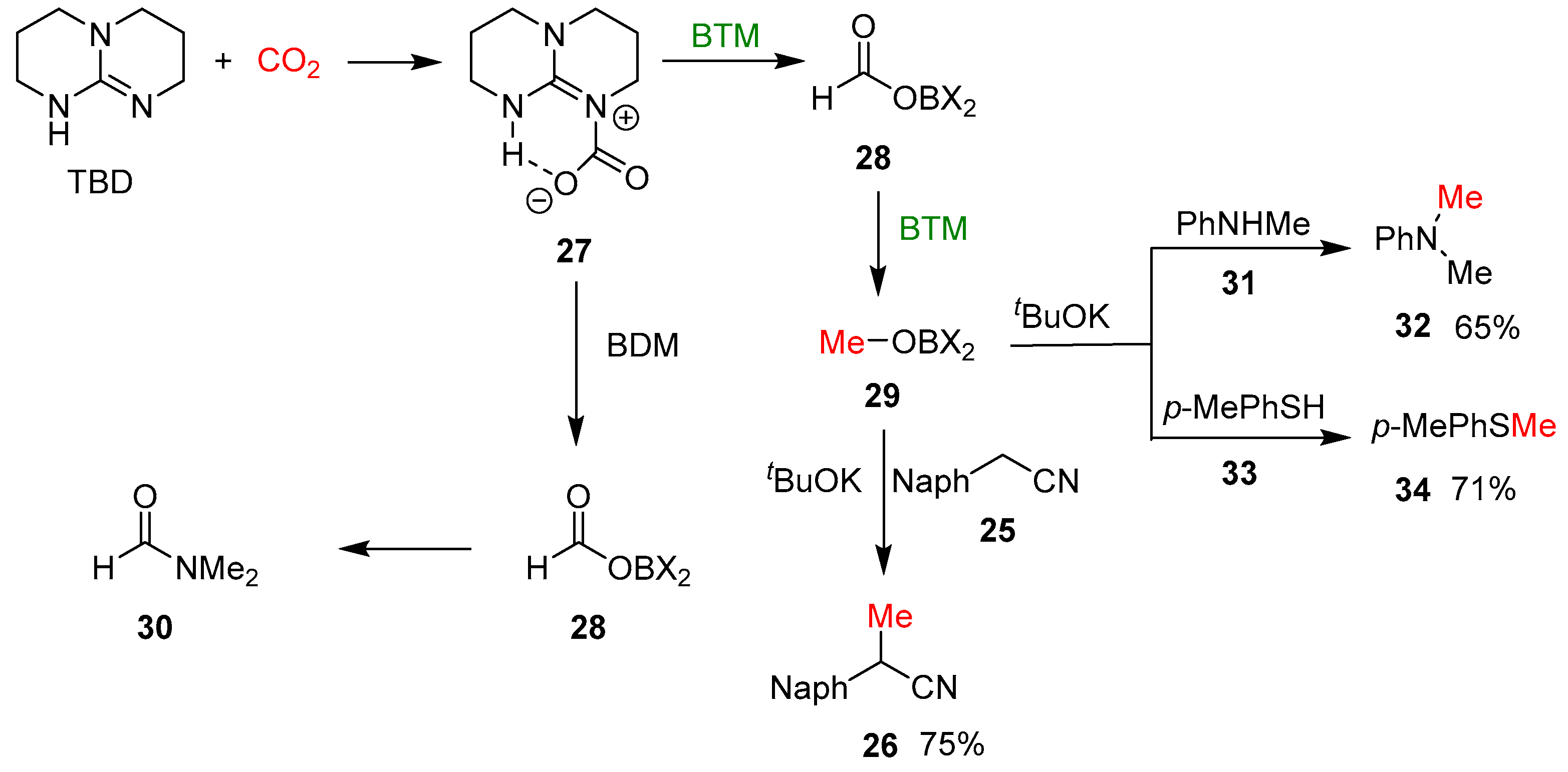



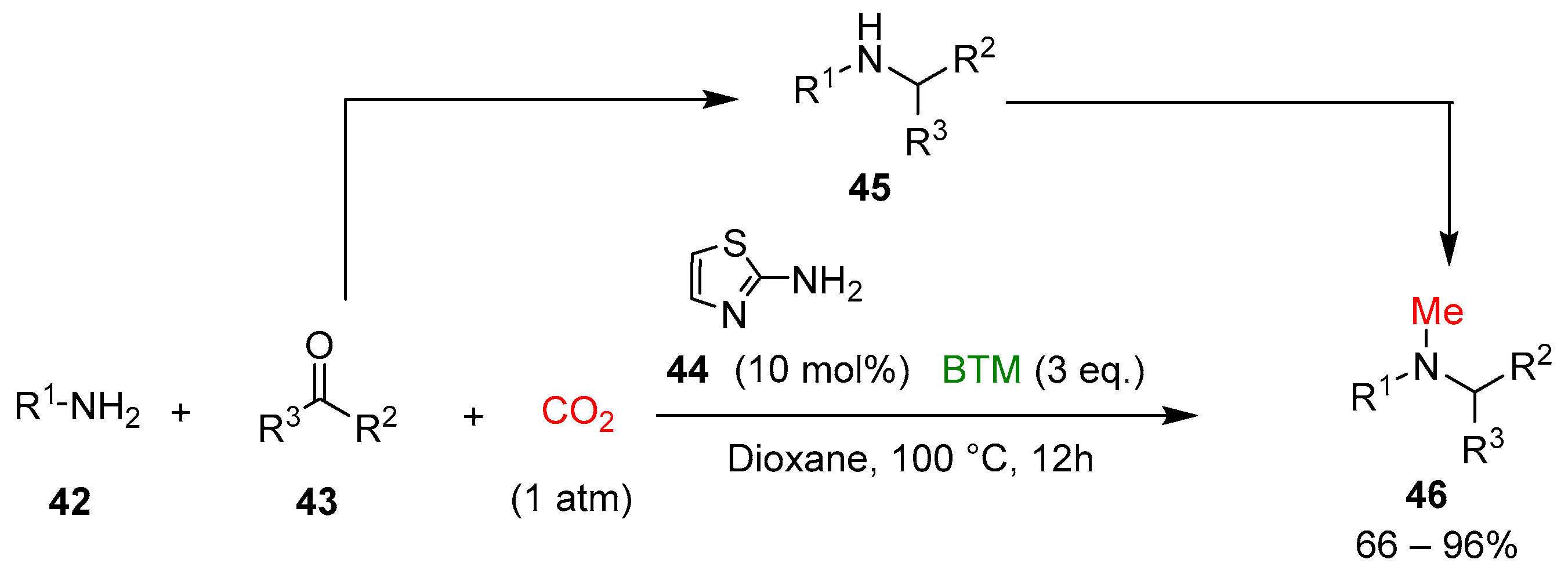



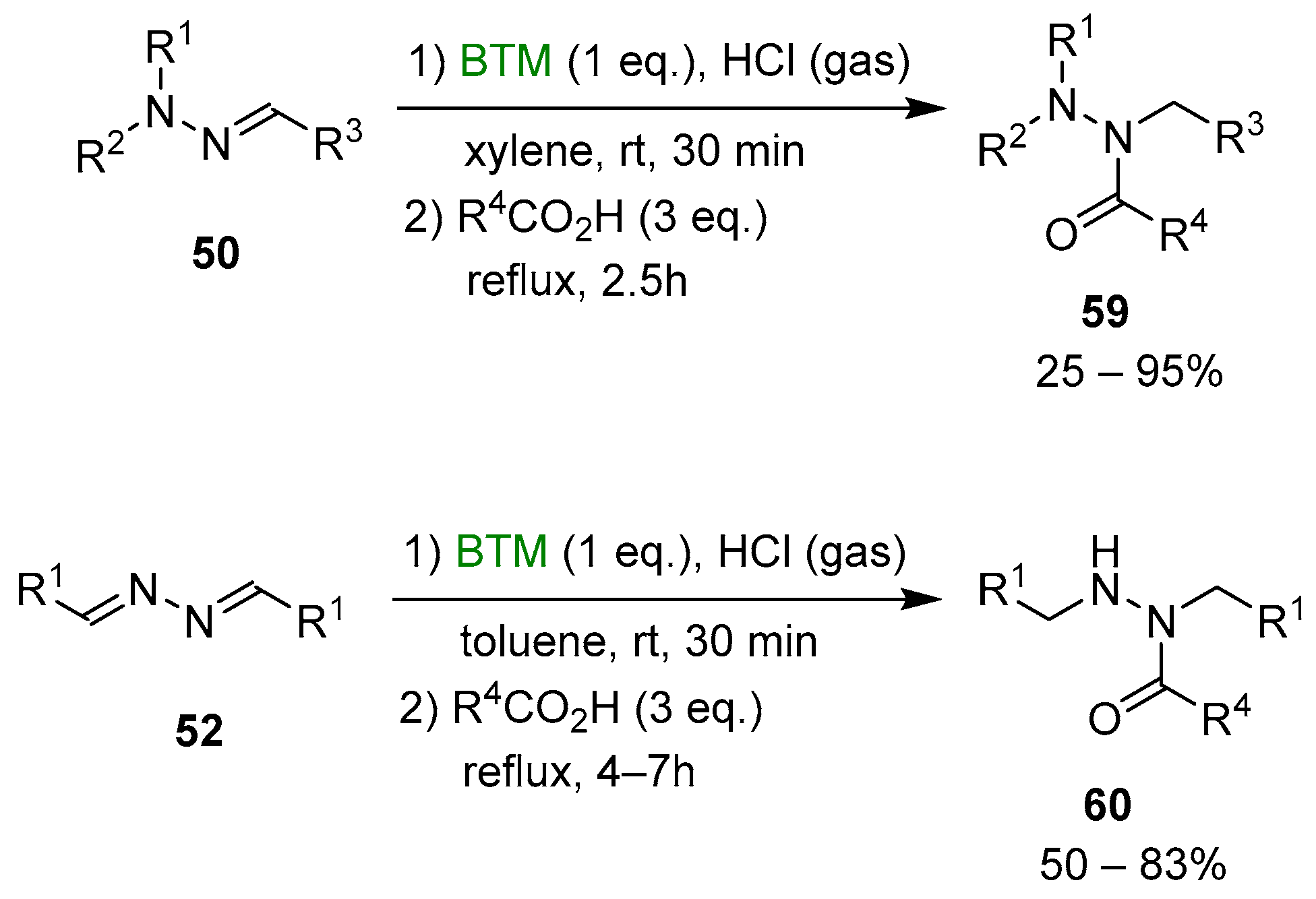



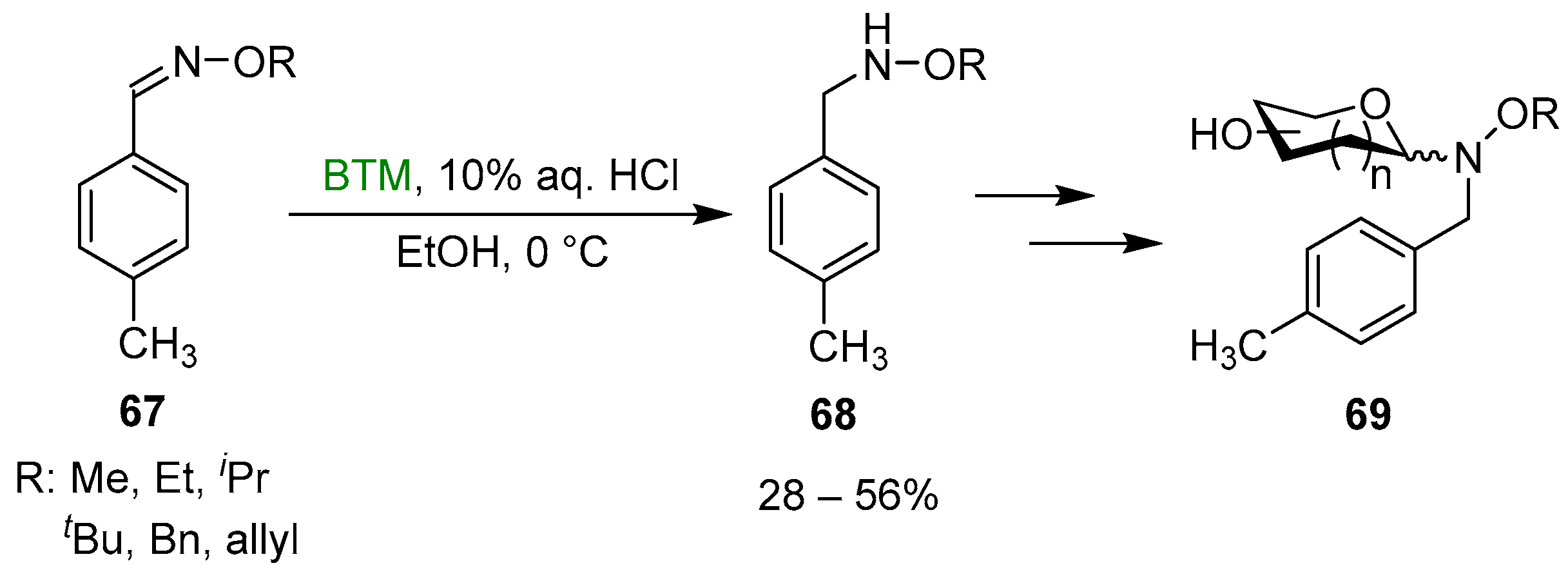


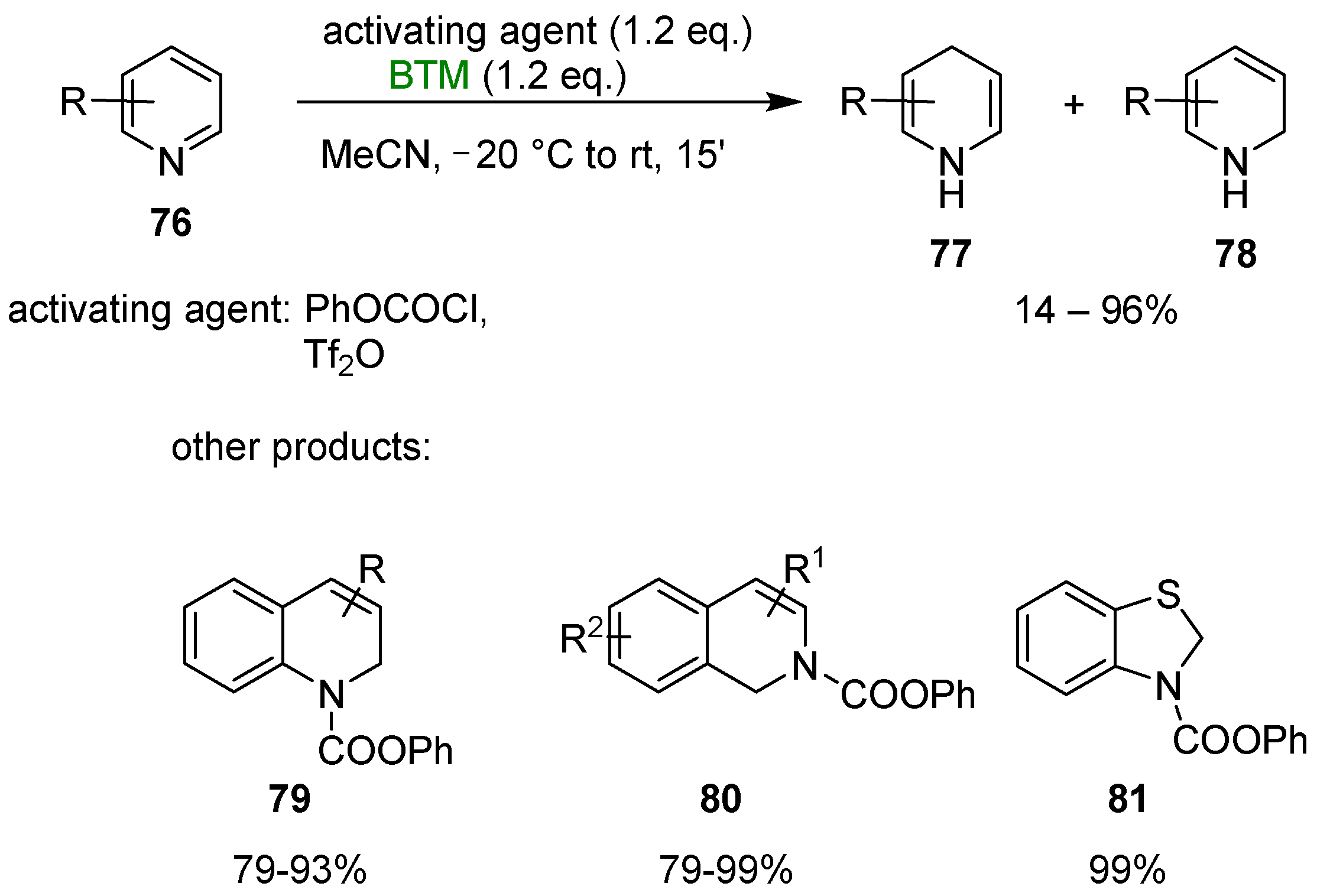








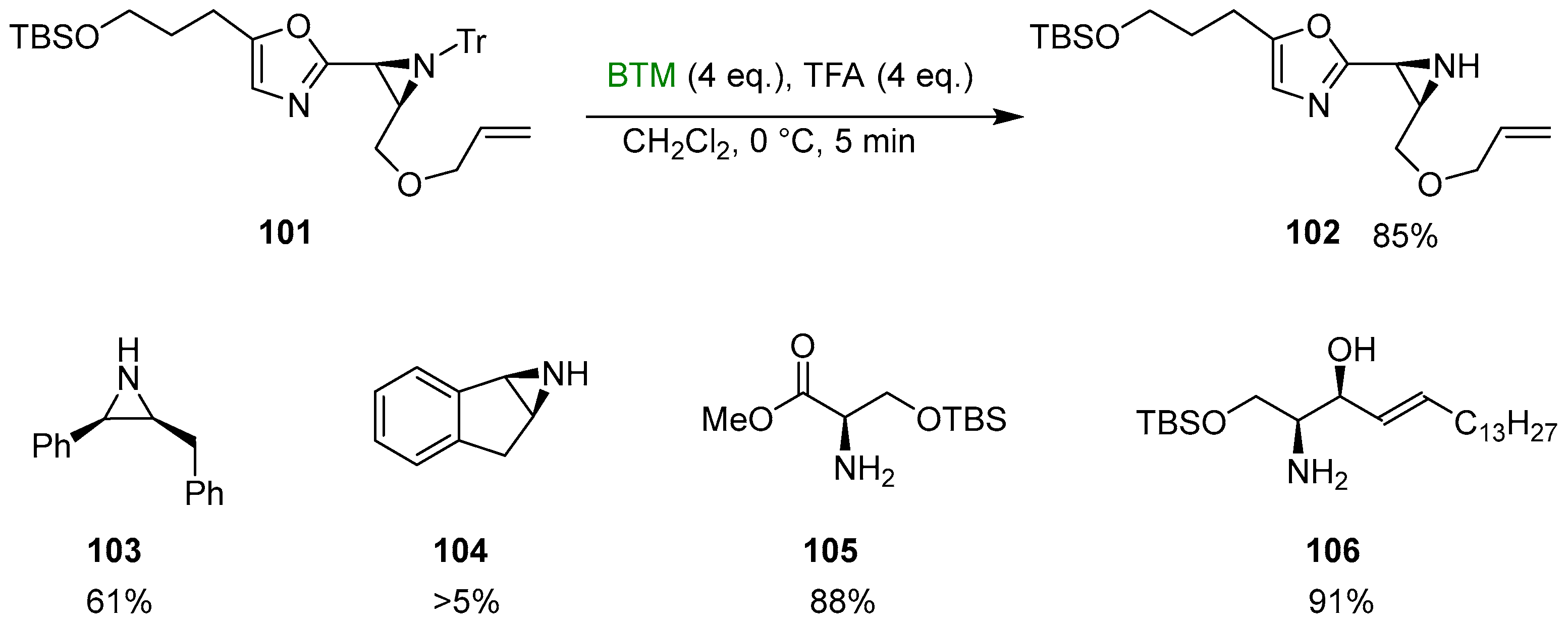
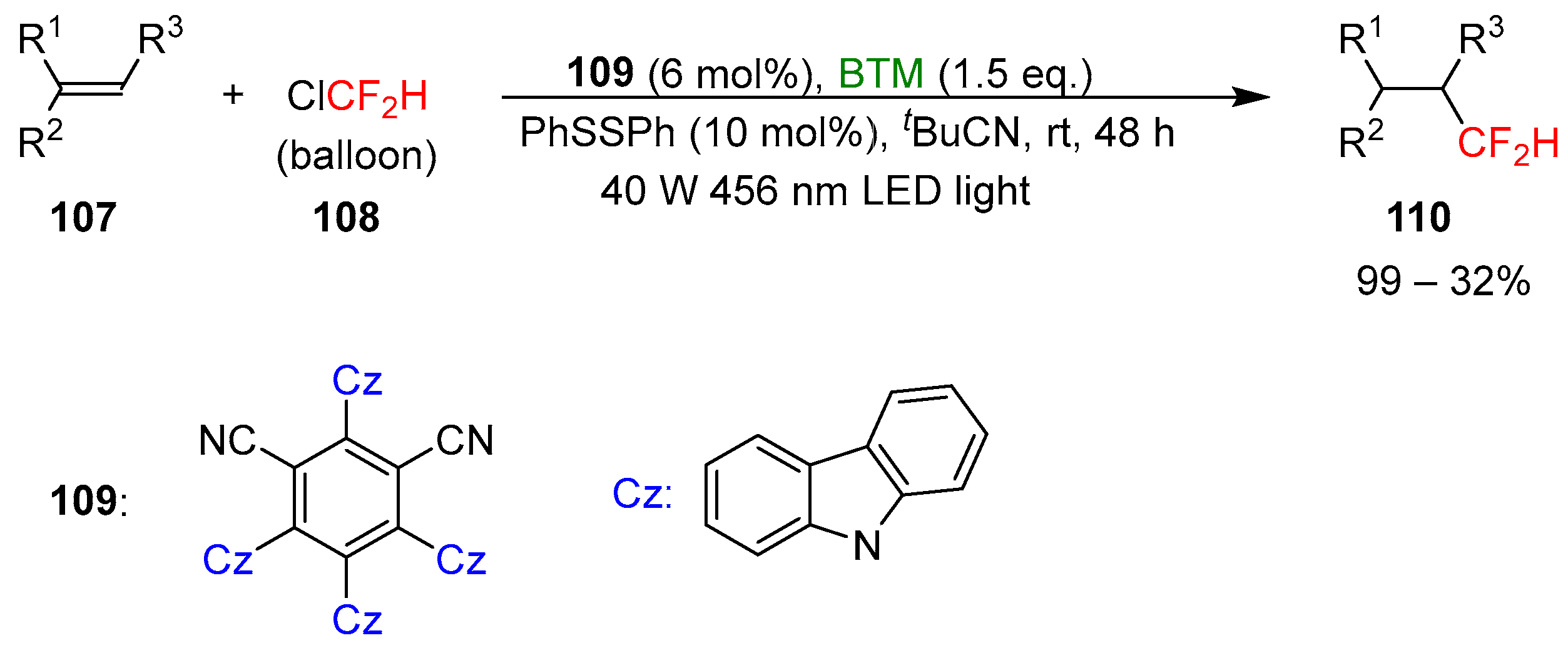
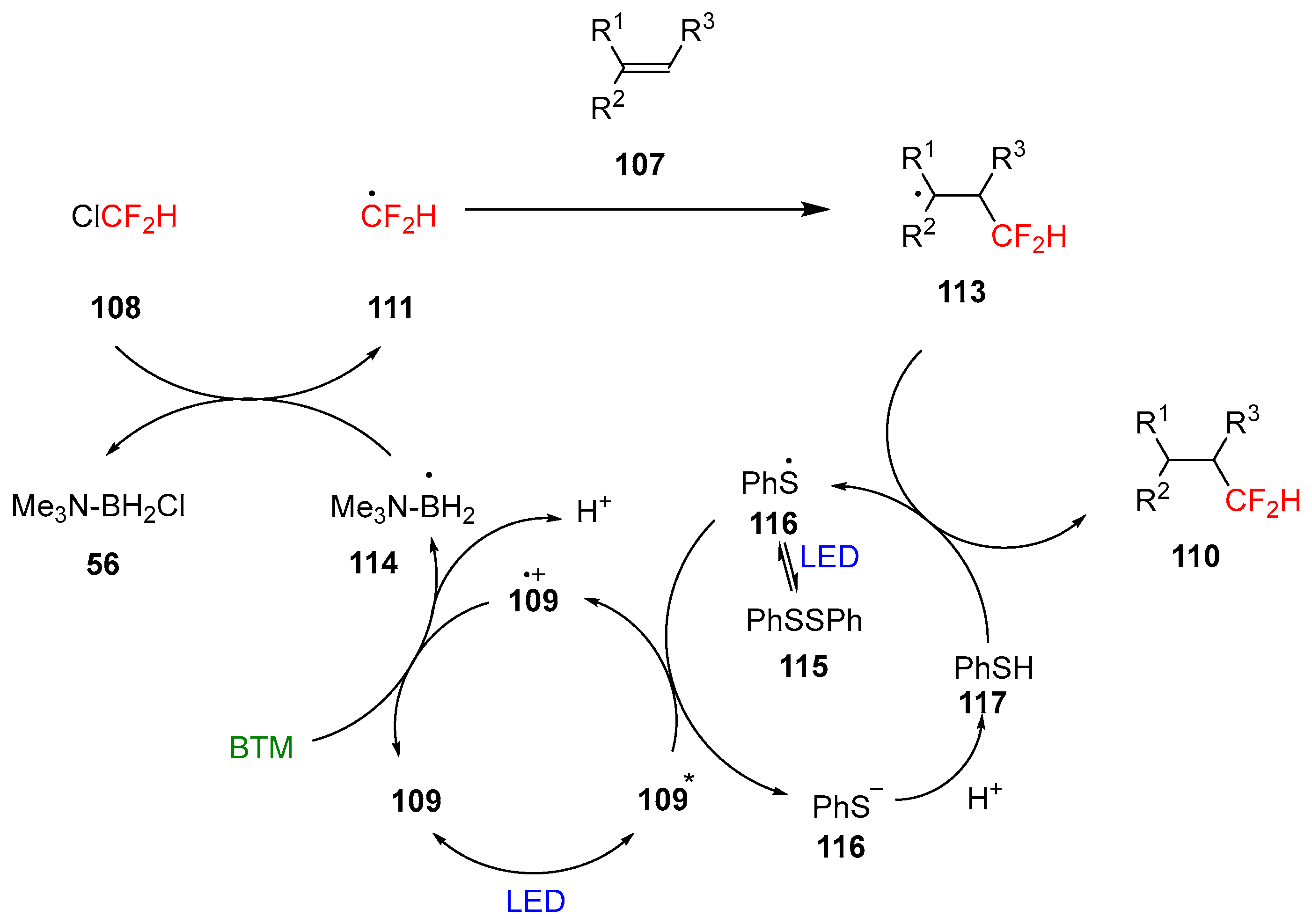



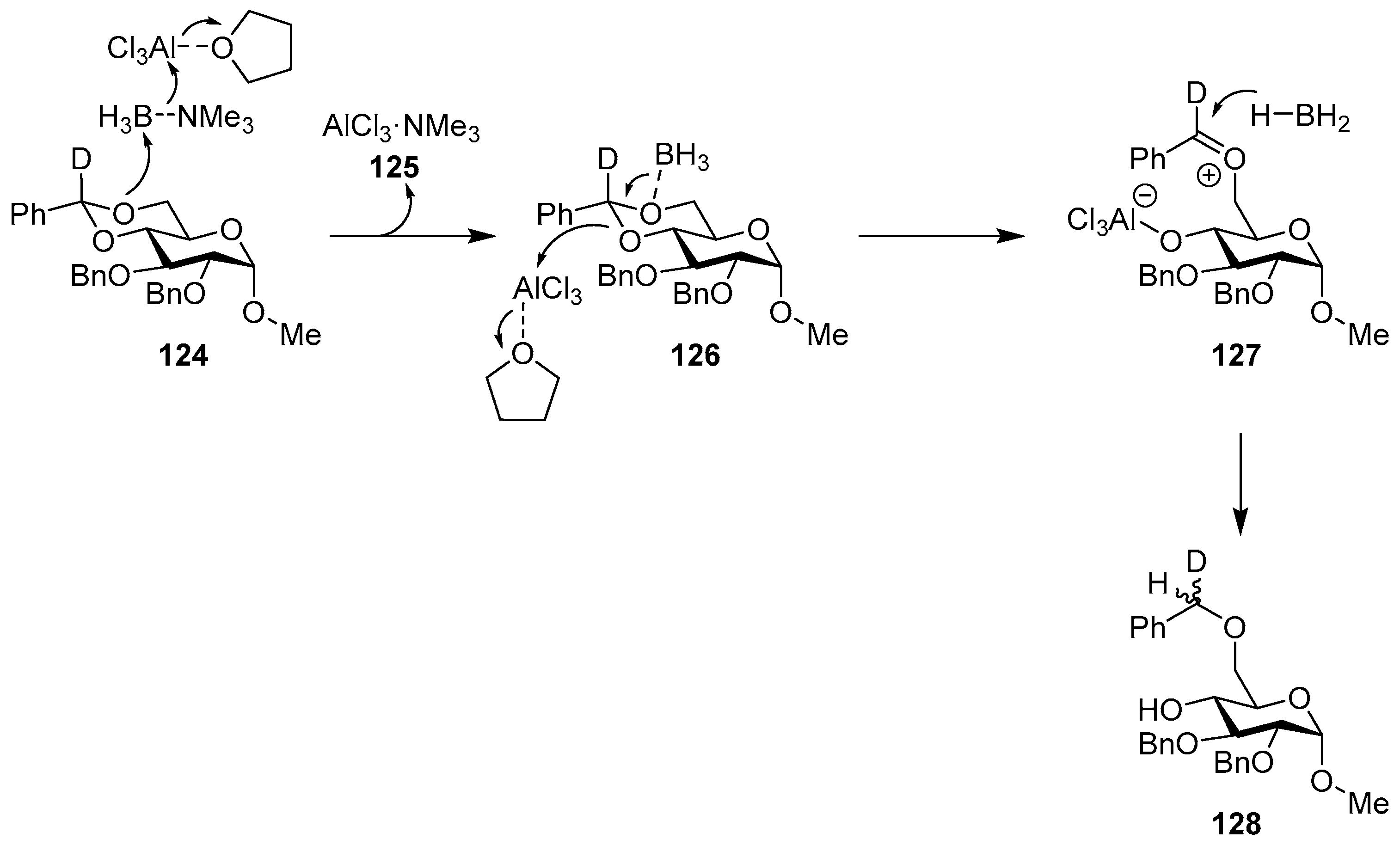

Disclaimer/Publisher’s Note: The statements, opinions and data contained in all publications are solely those of the individual author(s) and contributor(s) and not of MDPI and/or the editor(s). MDPI and/or the editor(s) disclaim responsibility for any injury to people or property resulting from any ideas, methods, instructions or products referred to in the content. |
© 2024 by the author. Licensee MDPI, Basel, Switzerland. This article is an open access article distributed under the terms and conditions of the Creative Commons Attribution (CC BY) license (https://creativecommons.org/licenses/by/4.0/).
Share and Cite
Perdicchia, D. Borane–Trimethylamine Complex: A Versatile Reagent in Organic Synthesis. Molecules 2024, 29, 2017. https://doi.org/10.3390/molecules29092017
Perdicchia D. Borane–Trimethylamine Complex: A Versatile Reagent in Organic Synthesis. Molecules. 2024; 29(9):2017. https://doi.org/10.3390/molecules29092017
Chicago/Turabian StylePerdicchia, Dario. 2024. "Borane–Trimethylamine Complex: A Versatile Reagent in Organic Synthesis" Molecules 29, no. 9: 2017. https://doi.org/10.3390/molecules29092017
APA StylePerdicchia, D. (2024). Borane–Trimethylamine Complex: A Versatile Reagent in Organic Synthesis. Molecules, 29(9), 2017. https://doi.org/10.3390/molecules29092017





